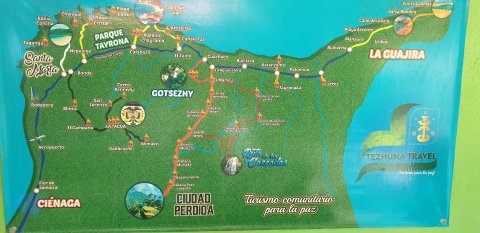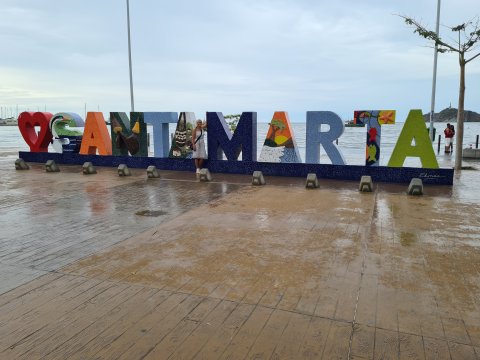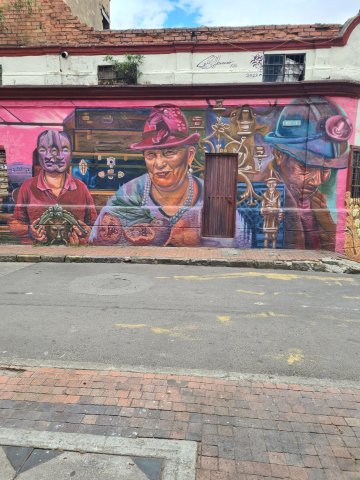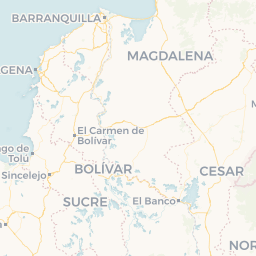
After winning the battle against all the little bugs in the boat, we could now declare it both bug and mold free - at least for the time being. We made sure there were chafing pads and shock absorbers on the mooring lines, packed up the dinghy and stowed away as much as possible below deck. Now we could lock up and leave the boat for slightly longer periods.
The first visit was the regional capital Barranquilla in the department of Atlantico in Colombia to which Puerto Velero and its surroundings belong. The journey there was a little adventure in itself. We decided to do like the locals and therefore went by public transport. The first stretch of 4.5 km to a major road we had to take motorcycle taxis, an illegal activity that many people make a living from and that the authorities often turn a blind eye to. 2 guys picked us up at the marina and drove us carefully all the way. Afterwards they asked if we could ride comfortably on the back of the bikes and gave us their number in case we needed a ride again. They took 5,000 COP (Colombian Pesos) per person, which corresponds to just under SEK 13. Then we stood by the side of the road and waited for the bus to Barranquilla. The buses run approximately every half hour so no timetable is needed 😊. When a bus arrived, we waved it in and were quickly seated in two free seats. In addition to the driver, there was a bus conductor/collector on the bus who took payment. For the distance we were going (about 30 km) the cost was 7,000 COP/person. Very affordable in our opinion. The bus ride itself was entertaining. After all, we had tried the adventurous bus trips in the minibuses on the Caribbean islands and thought that nothing could top these experiences. However, Colombian bus trips are probably still quite high in the adventure league. The buses on the route we traveled had around 40 seats, the AC consisted of open windows, and sometimes, open doors. At various stops along the way, passengers got on and off, as usual, but sometimes a salesman could also get on board and, for example, sell some dried banana snacks or corn cakes to the passengers who wanted something to munch on during the journey. Kind of like the popcorn vendors in the stands during a sporting event. At one point we heard a terrible noise at the back of the bus and when we turned around we discovered an elderly man who was also a one-man orchestra who had got on at the back in the bus. The man played the harmonica and kept the beat with a so-called guiro. In between he sang. After two performances, he walked around in the bus and took payment. It must be admitted that we found there was a lot to be desired in terms of the music experience and apparently most of the passengers felt the same. However, a lady took pity and gave him a penny, before he got off at the next stop. Afterwards we were ashamed as we had not given him anything at all. After all, the man's effort was still better and perhaps more worthy than "just" begging...
In Barranquilla we had booked an overnight stay at a hotel. We wanted to stay a few days to be able to see a bit of the city and have time to shop for fresh produce as there is no access to shops at the marina. In addition, a lady in the group (we won't mention name) had her birthday the following day, so we treated ourselves to luxury in the form of a hotel room with a real bed, AC and private bathroom with shower! We noted that this was the first time we did not sleep in the boat since we visited Sweden in December. The next day, Christer offered a birthday present in the form of a guide who would take us on a historical city walk through Barranquilla's older neighborhoods.
The guide, Jaime, turned out to be a nice and historically interested young guy. After hearing about what we were interested in, he told us briefly about the history of Colombia. The time before the Spanish conquest (1499) he did not know much more than that there were many different Indian peoples living in different parts of South America. When the Spanish arrived, what is today Colombia, Panama, Venezuela and Ecuador became a colony called New Grenada. At the beginning of the 19th century, the national hero Simón Bolivar led revolts against the Spanish and in 1819 they succeeded in freeing themselves from Spanish rule and declaring an independent Greater Colombia which functioned as a strong union between the different areas. Unfortunately, the union did not last long and in 1830 present-day Venezuela and Ecuador broke away and formed their own states. According to Jaime, the United States was early on interested in contributing to a canal that would connect the Caribbean Sea (and the Atlantic) with the Pacific Ocean through Panama, which was then a department of Colombia. For various reasons, including civil war, the Colombian government was not on board and at the beginning of the 20th century, Panama declared itself independent, backed by the United States, which in return could build the Panama Canal. It all went without bloodshed, but Jaime believed that the government in Colombia, at that time, could have played it’s cards better against the United States and thus been able to keep Panama.
Furthermore, Jaime told us that Colombia has a coast on both the Pacific and Caribbean seas. The country encompasses several climate zones and includes parts of the Andes Mountain range in the west and the Amazon rainforest in the east. Colombia is the world's third largest coffee producer and is rich in natural resources, but unfortunately the resources are not distributed fairly, he said. Much because of the corruption that still characterizes the country.
Barranquilla is a strategically important city due to its location on the Caribbean Sea. The great river Magdalena whose flow begins in the Andes flows right next to it and is important for transport and industries. The city has an old history and was inhabited much earlier than when the city was formally mentioned in the early 1800s. Excavations are underway to find out more about early Indian settlements in the area, but unfortunately there is a lack of funds to be able to do more thorough studies. The city was early with many "innovations", such as South America's first airport in 1909.
During the city tour, Jaimie showed us, among other things, the great cathedral Catedral metropolitana María Reina de Barranquilla, which began to be built in 1955-1980, designed by two different architects in a modernist style with a fantastic statue of Christ in bronze near the altar. The statue symbolizes how Christianity was brought via sea from Spain to South America and where three human figures follow Jesus and these represent the European, the African and the Indian (the indigenous population). The three peoples that make up the origin of the Colombians. There was of course even more to learn about the cathedral but this was what we managed to capture... We also got to see the impressive older cathedral which still has great historical and religious value. Furthermore, he showed us the Peace Square (Plaza de la paz) and a statue of Bolivar. Thereafter we looked at many older buildings in the Art Deco style that were built in the 1930-50 during a period when the city had a political and economic boom and wanted to show that Barranqilla was a modern city that could measure up to the European ones in terms of economy, culture and architecture. Here there were, among other things, office buildings, a hotel building, a cinema/theatre, a brewery, etc. All buildings that were now empty or housed other businesses.
Jaime then showed us a neighborhood that we had never dared to visit on our own, teeming with life and sound. Here there were rolling market stalls where the vendors marketed their wares via large loudspeakers with recorded harangues. Here, meat and fish were cut up on large tables in the street. Here beggars sat by the house walls, rats scuttled here and there and dogs ran around in piles of garbage that were scattered everywhere. Bicycle taxis, rickshaws, cars... Yes, a chaotic life that was both colorful and beautiful but at the same time testified to misery. It was an overwhelming experience and we didn't take any pictures… Jaime was enthusiastic and even though we already took up too much of his time, he insisted on ending the tour at the new tourist and recreation trail that was recently inaugurated next to the Magdalena River. He ordered an Uber taxi and shortly afterwards we ended up at a long and beautiful pedestrian street where residents and visitors could stroll or arrange a picnic. Here there were areas for play and sports activities, skateboard tracks, outdoor gym, etc. Here they had also chosen to honor one of the city's heroines with (another) statue. Shakira! She had previously been presented with a statue at another location in Barranquilla, but this one was bigger and did her better justice, most people seemed to think. The singer comes from Barranquilla and has also done a lot for her hometown. Among other things, she started the "Fundación Pies Descalzos" (Barefoot Foundation) to help children with difficult living conditions and she is immensely popular here. Our guide had taken great care to take pictures of us at each site and there will therefore be, for the sake of variety, many pictures below, taken by him where we ourselves are included 😊
This is where our city tour with Jaime ended. A versatile guy who has traveled to many countries – even in Europe, completed a triathlon, is a good dancer (we got to see proof of this in some film clips…) and is always curious to learn more. We parted with some pain, he gave us much more of his time than he should have and we are so grateful!
~~~~~~~~~~~~~~~
Efter att ha vunnit mot alla småkryp i båten kunde vi nu förklara den både kryp- och mögelfri - i alla fall för tillfället. Vi såg till att det fanns skavskydd och ryckdämpare på förtöjningstampar, packade ihop gummibåten och stuvade undan så mycket som möjligt under däck. Nu kunde vi låsa och lämna båten lite längre perioder.
Första besöket blev regionhuvudstaden Barranquilla i departementet Atlantico i Colombia dit Puerto Velero med omnejd tillhör. Färden dit var ett litet äventyr i sig. Vi bestämde oss för att göra som lokalbefolkningen och åkte därför kollektivt. Första sträckan på 4,5 km till en större väg fick vi ta med motorcykeltaxi, en illegal verksamhet som många livnär sig på och som myndigheterna ofta blundar för. 2 killar hämtade upp oss vid marinan och körde oss försiktigt hela vägen. Efteråt frågade de om vi kunnat åka bekvämt bak på cyklarna och gav oss deras nummer ifall vi behövde skjuts någon mer gång. De tog 5 000 COP (Colombianska Pesos) per person, vilket motsvarar knappt 13 kr. Därefter ställde vi oss vid vägkanten och väntade på bussen till Barranquilla. Bussarna går varje halvtimme ungefär så någon tidtabell behövs inte 😊. När en buss dök upp vinkade vi in den och fick snabbt sätta oss på två lediga platser. Förutom chauffören fanns en busskonduktör/inkastare med på bussen som tog betalt. För den sträckan vi skulle åka (ca 30 km) kostade det 7 000 COP/person. Väldigt överkomligt pris tyckte vi. Själva bussresan var underhållande. Vi hade ju provat de äventyrliga bussresorna i minibussarna på de karibiska öarna och tänkte att inget kunde toppa dessa upplevelser. Men, colombianska bussresor ligger nog ändå ganska högt i äventyrsligan. Bussarna på den sträckan vi åkte hade runt 40 sittplatser, AC:n bestod av öppna fönster, och ibland, öppna dörrar. Vid olika stopp längs vägen steg det på och av passagerare, som brukligt, men ibland kunde också en försäljare kliva ombord och t ex sälja lite torkade banansnacks eller majskakor till de passagerare som villa ha något att tugga på under resan. Ungefär som popcornförsäljarna på läktaren under ett sportevenemang. Vid ett tillfälle började det låta förfärligt bak i bussen och när vi vände oss om upptäckte vi en äldre man tillika enmansorkester som klivit på längst bak. Mannen spelade munspel och höll takten med en s k guiro. Däremellan sjöng han. Efter två framträdanden gick han runt i bussen och tog betalt. Det måste erkännas att vi tyckte att det fanns mycket i övrigt att önska vad gäller musikupplevelsen och tydligen tyckte de flesta passagerarna detsamma. En dam förbarmade sig dock och gav honom en slant, innan han klev av vid nästa hållplats. Efteråt skämdes vi då vi inte givit honom något alls. Trots allt var mannens ansträngning ändå bättre och kanske värdigare än att ”bara” tigga…
I Barranquilla hade vi bokat övernattning på hotell. Vi ville stanna några dagar för att kunna se lite av staden och hinna handla färskvaror då det inte finns tillgång till affär vid marinan. Dessutom skulle en dam i sällskapet (vi nämner inga namn) fylla år dagen därpå så vi unnade oss lyx i form av hotellrum med en riktig säng, AC och eget badrum med dusch! Vi konstaterade att detta var första gången vi inte sov i båten sedan vi besökte Sverige i december. Nästa dag bjöd Christer på en födelsedagspresent i form av en guide som skulle ta oss på en historisk stadsvandring genom Barranquillas lite äldre kvarter.
Guiden Jaime, visade sig vara en trevlig och historieintresserad ung kille. Efter att ha hört sig för om vad vi var intresserade av, berättade han kort om Colombias historia. Tiden före spanjorernas erövring (1499) visste han inte så mycket om mer än att det fanns många olika indianfolk som bodde i olika delar av Sydamerika. När spanjorerna kom blev det som idag är Colombia, Panama, Venezuela och Ecuador en koloni som kallades för Nya Grenada. I början av 1800-talet ledde nationalhjälten Simón Bolivar revolter mot spanjorerna och 1819 lyckades man frigöra sig från det spanska herraväldet och utropa ett självständigt Gran Colombia (Storcolombia) som fungerade som en stark union mellan de olika områdena. Tyvärr höll inte unionen länge och 1830 bröt sig nuvarande Venezuela och Ecuador ur och bildade egna stater. Enligt Jaime var USA tidigt intresserade av att bidra till en kanal som skulle förbinda Karibiska havet (och Atlanten) med Stilla havet genom Panama som då var ett av Colombias departement. Av olika skäl, bland annat inbördeskrig, var inte Colombias regering med på noterna och i början av 1900-talet förklarade sig Panama självständigt uppbackat av USA som i utbyte fick bygga Panamakanalen. Det hela gick oblodigt till men Jaime menade att dåvarande styret i Colombia kunde ha skött korten bättre gentemot USA och därmed kunnat behålla Panama.
Vidare berättade Jaime att Colombia har kust mot både Stilla havet och Karibiska havet. Landet omfattar flera klimatzoner och inkluderar delar av bergsmassivet Anderna i väster och Amazonas regnskogar i öster. Colombia är världens tredje största kaffeproducent och är rikt på naturtillgångar men tyvärr fördelas inte resurserna rättvist, menade han. Mycket på grund av den korruption som fortfarande präglar landet.
Barranquilla är en strategiskt viktig stad på grund av sitt läge vid Karibiska havet. Den stora floden Magdalena vars flöde börjar i Anderna flyter precis intill och har betydelse för transport och industrier. Staden har en gammal historia och var bebodd långt tidigare än då staden formellt började omnämnas i början av 1800-talet. Utgrävningar pågår för att få reda på mer om tidiga indianbosättningar i området men det saknas tyvärr medel för att kunna göra grundligare studier. Staden var tidig med många ”nymodigheter” som t ex Sydamerikas första flygplats 1909. Under stadsvandringen visade Jaimie oss bla a den stora katedralen Catedral metropolitana María Reina de Barranquilla som började byggas 1955-1980 ritad av två olika arkitekter i modernistisk stil med en fantastisk kristusstaty i brons nära altaret. Statyn symboliserar hur kristendomen fördes via havet från Spanien till Sydamerika och där tre människogestalter följer Jesus och dessa representerar europén, afrikanen och indianen (urbefolkningen). De tre folk som utgör colombianernas ursprung. Det fanns såklart ännu mer att lära sig om katedralen men detta var det vi hann snappa upp… Vi fick också se den imponerande äldre katedralen som fortfarande har ett stort historiskt och religiöst värde. Vidare visade han oss Fredens torg (Plaza de la paz) och en staty av Bolivar. Vi fick därefter besöka många äldre byggnader i Art Deco-stil som byggdes under 1930-50 under en period då staden hade ett politiskt och ekonomiskt uppsving och man ville visa att Barranqilla var en modern stad som kunde mäta sig med de europeiska vad gäller ekonomi, kultur och arkitektur. Här fanns bl a kontorsbyggnader, hotellbyggnad, biograf/teater, bryggeri etc. Alla byggnader som nu stod tomma eller hyste annan verksamhet.
Jaime visade oss sedan en stadsdel som vi aldrig hade vågat besöka på egen hand med ett myller av liv och ljud. Här fanns rullande marknadsstånd där försäljarna marknadsförde sina varor via stora högtalare med inspelade haranger. Här styckades kött och fisk på stora bord på gatan. Här satt tiggare vid husväggarna, råttor kilade av och an och hundar rusade runt i högar av sopor som låg utspridda här och var. Cykeltaxi, rickshaws, bilar… Ja, ett kaotiskt liv som både var färgstarkt och vackert men samtidigt vittnade om misär. Det var en överväldigande upplevelse och vi tog inga bilder… Jaime var entusiastisk och trots att vi redan tagit alltför stor del av hans tid insisterade han på att få avsluta turen vid den nya turist- och rekreationsstråket som nyligen invigts intill floden Magdalena. Han beställde en Uber-taxi och kort därefter hamnade vi vid en lång och vacker promenadgata där invånarna och besökare kunde promenera eller ordna med en picknick. Här fanns ytor för lek och sportaktiviteter, skateboardbanor, utegym o s v. Här hade man också valt att hedra en av stadens hjältinnor med (ytterligare) en staty. Shakira! Hon hade tidigare förärats en staty på en annan plats i Barranquilla, men denna var större och gjorde henne bättre rättvisa verkade de flesta tycka. Sångerskan kommer från Barranquilla och har också gjort mycket för sin hemstad. Bl a startat stiftelsen "Fundación Pies Descalzos" (Barefoot Foundation) till hjälp för barn med svåra levnadsförhållanden och hon är omåttligt populär här. Vår guide hade omsorgsfullt sett till att fota oss vid varje sevärdhet och det blir därför, för omväxlings skull, många bilder nedan, tagna av honom där vi själva är med 😊
Här avslutades vår stadsvandring med Jaime. En mångsidig kille som rest i många länder – även i Europa, genomfört en triathlon, är en duktig dansare (vi fick se bevis på detta i några filmklipp…) och är ständigt nyfiken på att lära sig mer. Vi skildes åt med viss vånda, han gav oss mycket mer av sin tid än han hade behövt göra och vi är så tacksamma!




























10 Commentaire(s)
Once again facinating. A wonderful experience and it brings into focus that there are many parts of the world where living conditions are not the same as ours.
20 August 2024 AnswerIn these perspectives, we must be happy for what we have
21 August 2024 AnswerTack det verkar väldigt intressant och trevligt..
20 August 2024 AnswerDet kommer mera 😊
21 August 2024 AnswerWOW
21 August 2024 Answer😁
21 August 2024 AnswerHow exciting your first adventure in Colombia. Looking forward to read about many more. Happy birthday Malin, nice that you treated yourself to a hotel with AC. Keep enjoying Columbia.
23 August 2024 AnswerThanks Caroline and take care. You'll enjoy Colombia too when you get here 😊
31 August 2024 AnswerUnderbart att fortsätta följa er resa. Kul att se foton på er båda! Ingen dålig födelsedag med både hotellsäng och AC 😂👏🤗 Längtar till nästa uppdatering Kramar
26 August 2024 AnswerKul att det uppskattas. Vi skriver mer så fort vi hinner. Hoppas ni har det bra!❤
31 August 2024 Answer